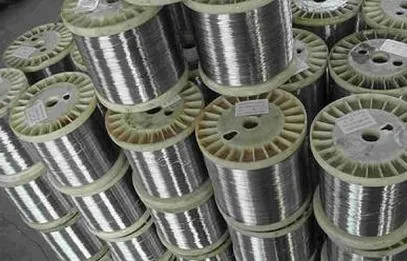 هاتف:
+86-13102802206
هاتف:
+86-13102802206
 بريد إلكتروني:
fencenetting@china.com
بريد إلكتروني:
fencenetting@china.com
 لغة
لغة
 هاتف:
+86-13102802206
هاتف:
+86-13102802206
 بريد إلكتروني:
fencenetting@china.com
بريد إلكتروني:
fencenetting@china.com
 لغة
لغة


In high-performance environments where strength, corrosion resistance, and consistency matter most, سلك غير قابل للصدأ stands as a cornerstone material for industries ranging from aerospace to medical, construction to jewelry-making. With unbeatable durability and forming flexibility, stainless wire delivers unmatched results no matter the application.

The production process of سلك غير قابل للصدأ is a perfect fusion of precision and innovation. After initial casting, stainless steel rods are cold-drawn through multiple dies to achieve the required diameter, resulting in high-tensile wire with exact dimensional accuracy. For custom diameters like 1mm stainless wire, specialized drawing dies ensure consistency down to microns, making the wire suitable for applications like fine mesh, cable production, and electronic components.
Forming سلك غير قابل للصدأ is equally impressive. The wire’s malleability allows it to be bent, coiled, or welded into complex shapes without compromising structural integrity. Advanced CNC machines are used to shear and form the wire into springs, screws, fasteners, and surgical instruments. Unlike other materials that may crack or deform under stress, ss 316 wire maintains excellent elasticity and strength during forming, making it ideal for marine-grade and chemical-resistant parts.
The shearing process—often done using rotary or guillotine cutters—ensures a clean cut without fraying or jagged edges. This is particularly important for medical and food-grade applications where precision and hygiene are critical. Whether you’re cutting 10-meter rolls or producing intricate coils, سلك غير قابل للصدأ delivers the kind of accuracy that industrial engineers and product designers can trust.
Proper storage of سلك غير قابل للصدأ is crucial to preserving its corrosion-resistant properties and mechanical strength. Although ss 316 wire is exceptionally resistant to oxidation and chlorides, poor storage conditions can lead to surface contamination that may compromise performance.
The first rule is to store سلك غير قابل للصدأ in a clean, dry, and well-ventilated environment. Avoid areas with high humidity, standing water, or exposure to acids and salts, as these can accelerate corrosion even on stainless-grade materials. Stainless wire should never be stored in direct contact with carbon steel or aluminum to prevent galvanic corrosion.
To prevent deformation, coils of 1mm stainless wire should be stored on non-reactive spools or racks that evenly distribute weight. Any tangling or bending during storage can lead to permanent kinks, which could hinder wire performance in applications requiring straightness or precision bends.
For long-term storage, the use of protective plastic wraps or vacuum-sealed containers is recommended. This shields the wire from dust, industrial particles, and contaminants that may compromise welding or bonding quality later in the production process.
At first glance, aluminum wire may seem like a lightweight and affordable alternative, but when performance and longevity are critical, سلك غير قابل للصدأ proves far superior. The key differences begin with strength—سلك غير قابل للصدأ offers much higher tensile strength than aluminum, allowing it to withstand more force before deforming. This makes it the preferred material for load-bearing or high-stress applications.
Corrosion resistance is another important distinction. While aluminum naturally oxidizes to form a protective layer, it is still susceptible to pitting and stress corrosion, especially in marine or industrial environments. Ss 316 wire, by contrast, includes molybdenum in its alloy composition, providing exceptional resistance to acids, salts, and harsh chemicals.
Thermal performance also favors سلك غير قابل للصدأ. While aluminum conducts heat more efficiently, it loses strength rapidly at high temperatures. Stainless wire, on the other hand, maintains structural integrity and resists thermal fatigue even at elevated temperatures, making it ideal for applications in power plants, aerospace, and industrial furnaces.
Finally, when it comes to fabrication, 1mm stainless wire offers better welding and forming properties than aluminum. It doesn’t require specialized equipment and is compatible with most industry-standard joining and bending methods, which enhances its versatility in complex assemblies.
One of the most popular and widely used grades of سلك غير قابل للصدأ is ss 316 wire, known for its marine-grade resilience and chemical resistance. Composed of chromium, nickel, and molybdenum, ss 316 wire is engineered for applications in saltwater, acidic, and high-moisture environments.
This makes ss 316 wire indispensable for shipbuilding, offshore platforms, and chemical processing equipment. Unlike standard stainless steels, which may corrode in chlorinated or brine conditions, ss 316 wire stands strong, maintaining its integrity over extended periods of use.
In architecture and design, the sleek, polished finish of ss 316 wire makes it ideal for decorative applications such as tension cables, wire balustrades, and mesh infill panels. It adds both strength and aesthetic appeal to modern structures.
For pharmaceutical and food-grade equipment, ss 316 wire is FDA-compliant and sterilization-safe, making it the go-to choice for wire baskets, filters, and mixing components. Its non-reactive surface ensures safety and hygiene in cleanroom environments.
Stainless wire is drawn through precision dies and sheared using rotary or guillotine cutters. It can then be bent, coiled, or formed using CNC machines without losing its strength or elasticity.
Store سلك غير قابل للصدأ in a dry, ventilated space away from humidity and other metals. Use protective covers or sealed packaging to prevent contamination and deformation.
Stainless wire offers superior strength, corrosion resistance, and high-temperature performance compared to aluminum wire, making it ideal for demanding environments.
1mm stainless wire is perfect for detailed applications like electronic components, surgical tools, and fine meshes due to its accurate diameter and excellent forming capability.
Ss 316 wire resists chloride corrosion, performs well in harsh environments, and meets industry standards for marine, pharmaceutical, and architectural applications.